Pedestrians Not Following Road Walking, Crossing Norms Cause Accidents: Govt Tells Rajya Sabha
Union government has told Parliament that pedestrian deaths in the country occur mostly because people do not follow the norms laid down for walking and crossing roads during traffic.

Evoking sharp criticism from experts, who questioned the Centre over lack of adequate walking infrastructure, the Union government has told Parliament that pedestrian deaths in the country occur mostly because people do not follow the norms laid down for walking and crossing roads during traffic.
Nitin Gadkari's reply in Parliament
In his written reply to a question by Bharatiya Janata Party (BJP) MP from Uttar Pradesh, Brij Lal, the minister submitted to the Upper House, ¡°No study on why pedestrian deaths happen is available or has been conducted. Generally, such deaths occur due to pedestrians not following norms laid down for walking along roads or trying to cross roads during traffic. Accidents also occur due to over-speeding vehicles.¡±
 PTI
PTI
Union transport minister Nitin Gadkari also said road crashes claimed the lives of 23,483 pedestrians in 2020. While in terms of absolute numbers such fatalities were less during the Covid year when there was restriction on vehicle movement as compared to 2019, there is an alarming trend of how the share of pedestrian deaths in all road fatalities increased from 10.5% in 2016 to nearly 18% during 2020.
No study yet on pedestrian deaths cause
The ministry also placed on record that the government has, so far, not conducted any study to analyse the causes of pedestrian deaths in the country. ¡°To prevent road accidents and save lives, the Motor Vehicle (Amendment) Act, 2019 passed by Parliament, focuses on road safety and includes, inter-alia, hike in penalties for traffic violations, electronic monitoring of the same, enhanced penalties for juvenile driving, computerisation/automation of vehicle fitness and driving, tests, recall of defective vehicles, streamlining the third-party insurance and payment of increased compensation for hit and run cases etc. The Amendment has strengthened the law to improve the road safety scenario and reduce loss of lives. However, no study on why pedestrian deaths happen is available or has been conducted,¡± the reply stated.
 BCCL
BCCL
Road accident data
This comes as reports suggested that in 2020 India recorded 1.2 lakh cases of ¡°deaths due to negligence relating to road accidents¡±. In other words, 328 people are losing their lives every day on average, according to government data.
Though the 1.2 lakh deaths in 2020 was less than the fatalities in the pre-pandemic year which saw 1.36 lakh lived being lost on the roads, the numbers are alarming as the country was under complete lockdown from March 25 to May 31 due to the COVID-19 pandemic, during which the movement in public space was ¡°very limited¡±.
As many as 3.92 lakh lives have been lost in three years in deaths due to negligence related to road accidents, the National Crime Records Bureau (NCRB) revealed in its annual ¡®Crime India¡¯ report for 2020. While 1.2 lakh deaths were recorded in 2020, the figures stood at 1.36 lakh in 2019 and 1.35 lakh in 2018, the data show.
 PTI
PTI
Experts' sharp reactions
Reacting sharply to the Centre¡¯s reply on pedestrian deaths, Kamal Soi, member of the National Road Safety Council, said the government¡¯s approach to urban and safe mobility was wrong.
¡°This is a ridiculous and absurd answer and I, despite being a member of the government of India¡¯s road safety council, do not endorse this. We have not created the necessary infrastructure for pedestrians and still we have the audacity to blame them for their own deaths. It is the sole responsibility of all the agencies to create and ensure adequate infrastructure for safe pedestrian movement. The world is moving towards walking and cycling as a last-mile connectivity mode and here we have lawmakers having such a fundamentally wrong approach to policies,¡± Soi added.
 File
File
Shreya Gadepalli, managing trustee at Urban Works Institute, said designing cities for people rather than cars could ensure that ¡°streets are full of life, not deaths¡±.
¡°Road crashes have become so common that they hardly evoke any reaction in us anymore. There is disconnect in the way we design our streets and the way we want our drivers to behave. You may have often come across road signs that read: ¡°speed thrills but kills¡±. But if we want people to drive slower, why do we design streets as racing tracks? Why do we have highways within cities that become barriers for people to cross? Why is an attempt to even slightly widen footpaths seen as an encroachment on space that ¡°rightfully¡± belongs to motorists,¡± she added.
For more on news and current affairs from around the world, please visit Indiatimes News.
